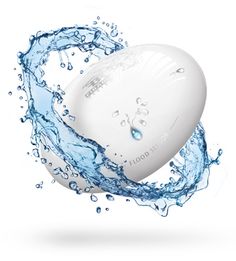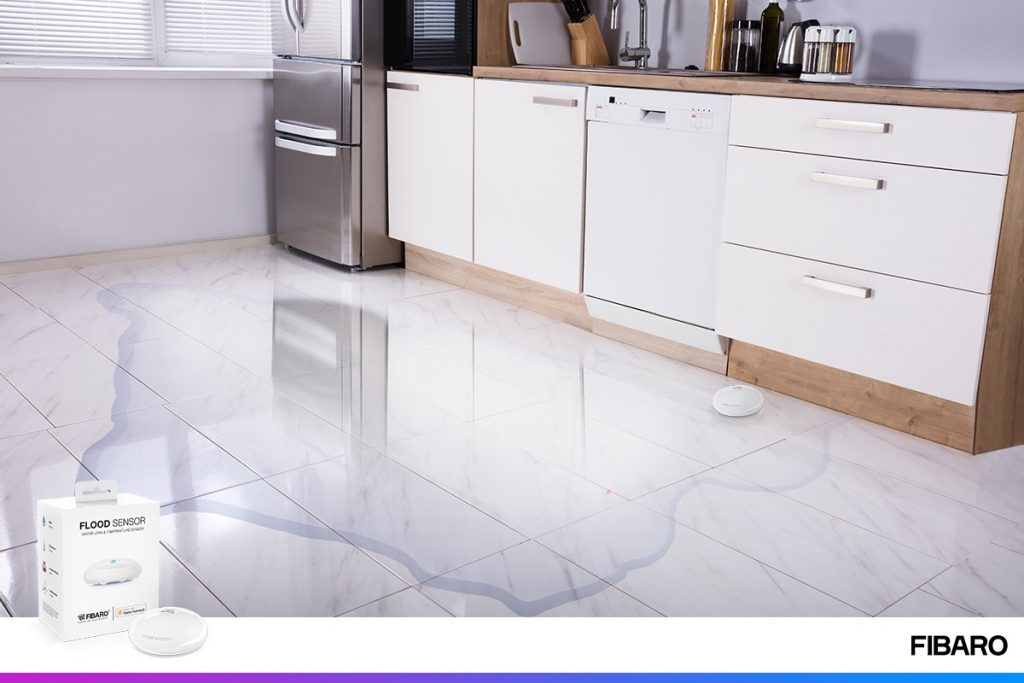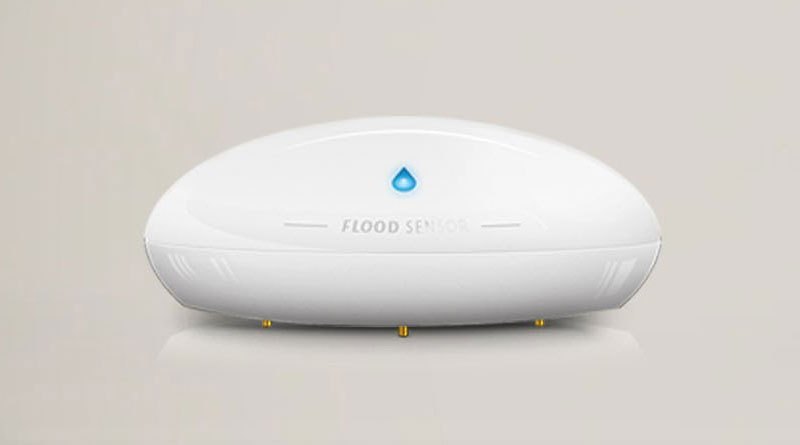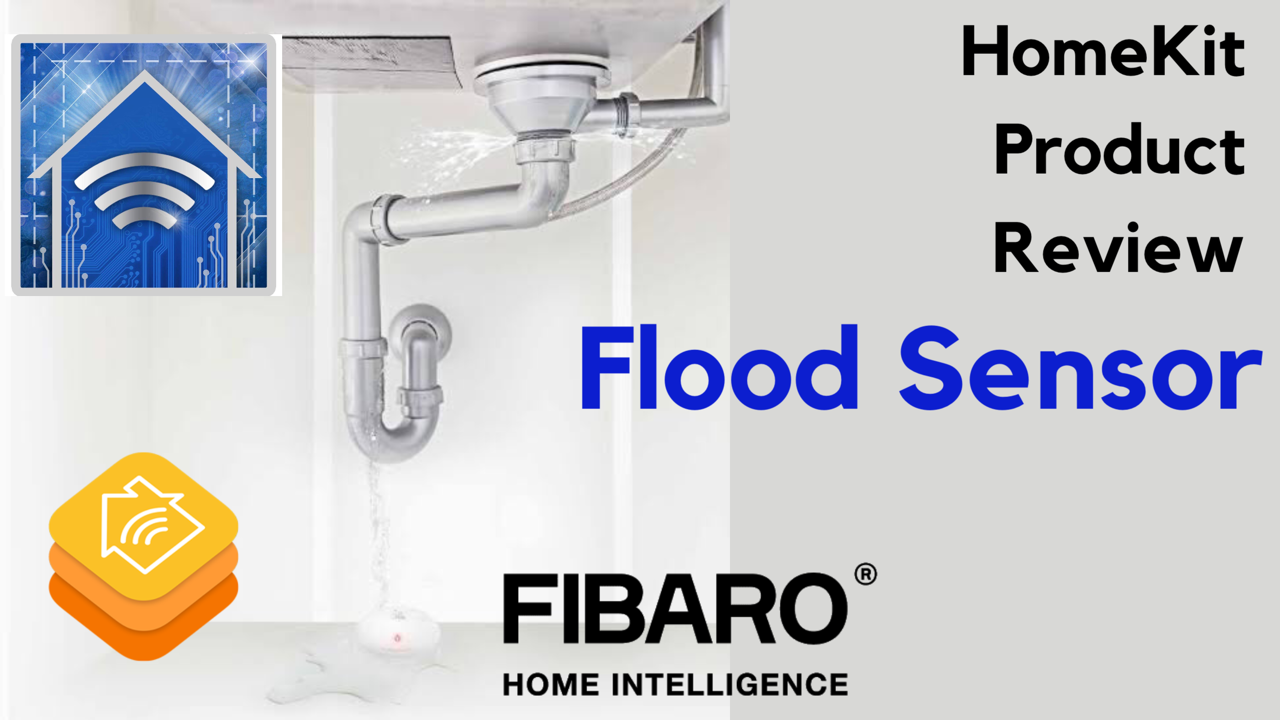Most sensors in HomeKit give us on-the-spot measurements, detect movement, or tell us whether something is open or closed and we can create automations based on this information, which is great for those day-to-day tasks, but what about those emergency situations? Having the lights turn on because you opened a door is convenient, but can this potentially avert disaster? The Fibaro Flood Sensor just might be able to do this and potentially save you a ton of money in the process.
A review unit was provided to myHomeKithome for the purpose of this review, but no compensation was received nor was the content reviewed before publishing. All thoughts expressed are purely those of my own.
Features
- 3 telescoping legs that detect liquid and allow the device to work on uneven surfaces
- LED indicator and audible alarm when liquid is sensed
- Temperature sensor
- Tamper sensor

- 1 x 1/2 AA batteries last about 2 years
- Bluetooth Low Energy
- 0 – 40 degree Celsius (32 – 104 Fahrenheit) operating temperature
Pros

Perhaps the biggest advantage that the Fibaro Flood Sensor has Is the fact that it was the first HomeKit-compatible water leak sensor. Other manufacturers have since announced flood sensors and Aqara is making a big push for its Hub which has a compatible water leak sensor, but the Flood Sensor still remains as the only widely available HomeKit water leak sensor as of the writing of this post.
With a simple and relatively compact design, the Fibaro Flood Sensor houses 3 separate sensors in a pretty small package: liquid, temperature, and tamper sensor. The fact that it doesn’t require a power supply is definitely a plus as in most places where you might place this sensor don’t often have an outlet nearby. On a side note, we do have the ability to connect lead wires to the sensor which will give you extended range of leak detection.
The combination of mobile notifications and the audible alarm is a pretty solid system for letting us know that there is potentially something terrible going on. The alarm that sounds when the device detects liquid while not at a smoke or CO alarm level, was sufficient enough for my neighbor to investigate during my testing.
Cons

Though it is a liquid sensor, it doesn’t have a stated IP rating and is intended for indoor use only. It might be nice to use this outside to make sure that things like spigots, pool pumps, or sprinkler systems aren’t leaking. Oddly enough, it does float, however.
Though it’s very likely due to the fact that it operates on standard batteries, the operating temperature range makes it impractical for places like basements where you might be concerned about flooding due to pipes bursting in the winter.
This is a limitation of the connection protocol used, but because it uses Bluetooth Low Energy to connect to HomeKit and the Fibaro app, the device must be within relatively close range for any alerts to be sent again making it not so ideal for basements, larger homes, or areas that don’t have a clear connection to a Home hub.
The App

Allow me to preface my thoughts on the app by encouraging you to make sure you download the correct one that is designated for HomeKit devices. I made this mistake, which was completely due to my own inability to read and follow directions, and it led to quite a bit of confusion.
Launching the app, we land on the “Dashboard” tab which has a very convenient add device (+) button predominantly at the top right which I appreciate. One thing I did find confusing about this tab is that there is no apparent semblance of organization of other HomeKit devices that are aggregated from our Home data. Moving to the right is a cleverly designed “Scenes tab which houses all of our imported HomeKit scenes and automations along with the ability to add new ones. I quite like the way the scenes and automations are presented allowing us quick and easy access to engage with them. I also appreciated how the “Rooms tab was organized by zones as a top-level way of navigating the home.
In terms of what we can do with the Flood Sensor itself inside the Fibaro app as opposed to other HomeKit apps is a little underwhelming. I was thinking that at least if HomeKit doesn’t currently support vibration or tamper sensors then surely Fibaro’s app would give us some options for notifications based on detected movement, but not as of yet. We can merely turn the tamper sensor on and off and adjust it’s sensitivity. I was also disappointed to see that after setting up the device, there were no firmware updates to greet me. This isn’t necessarily a bad thing, but when we do receive them it can sometimes indicate a company’s commitment to further improving the device.
Final Thoughts

As basically the only HomeKit water leak sensor currently on the market, it’s pretty compelling if you need to know if there is liquid somewhere it shouldn’t be. It has a solid design and build quality and functions as advertised. The addition of a temperature sensor is an added bonus and could come in quite handy to monitor temperatures around pipes that could freeze and create some pretty nasty damage. The tamper sensor is also a nice feature, but there’s not much we can do with it. Though we can get notifications on a leak that has been detected, temperature and tamper notifications might also be nice in order to potentially address the leak before it starts. Though this is a point for improvement on the HomeKit side, it could have been solved on Fibaro’s end through their app.
The Fibaro Flood Sensor does exactly what it says it will do and does it well given the device is in range of a home hub. My greater concern is not for the Flood Sensor itself and more regarding integration with other HomeKit accessories. There aren’t currently any smart valves on the market that might allow us to remotely stop the flow of water once a leak has been detected or better yet create an automation to do so. It’s also worth noting here that Aqara has a Vibration Sensor smilar to the tamper sensor and it does work with HomeKit though it shows as a motion sensor.
Where might you place a water leak sensor in your home? Can you think of any alternative ways of using the leak sensor other than for detecting leaks? The comment section awaits. If you simply can’t get enough HomeKit goodness, there is plenty of it waiting for you on our social media @myhomekithome.
Links & Resources
Learn more about Fibaro’s lineup of HomeKit connected home products at https://www.fibaro.com/en/homekit/
We use income-earning affiliate links.
We may receive a small commission on purchases made using links on this page at no extra cost to you.
